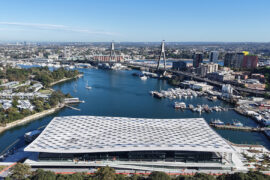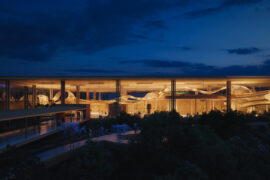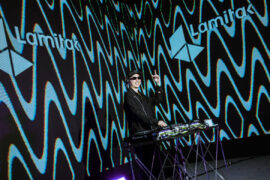In order to design into the future, first we must look back. In considering the state of workplace, learning and hospitality design, FRONT.design Ambassador, Simone Oliver of Architectus, outlines the defining influences of our time and design’s role within that.

Photo by David Wheeler
“The nature of work has radically changed,” says Simone Oliver, national sector leader – interior architecture at Architectus, and Ambassador to FRONT.design 2019. “The rise of technology, automation, globalisation” – these are the big-picture forces driving change. On the ground, we see it play out through rapidly growing markets like the gig economy and co-working. Influenced by a clashing of typologies in which seemingly disparate markets like social media, education and hospitality bring new depth to what was a clearly delineated field of reference.
Book tickets for FRONT.design’s Workplace Forum, 29 August. Seating limited, book now!

Incubator by Architectus
Work, says Simone, is something that has often separated us from family and home life. Nowadays, it is a connecting force that melds flexibly around our lives as we grow, learn, pursue personal interests and more.
We begin to consider ‘workplace’ in a different light, says Simone. “Is our workplace now becoming a university? Or, what if our home became our workplace? Or, what if I work out of a hotel lounge every day? Or, what if my children’s school was starting to become my workplace?” (The latter in reference to WeWork’s introduction of WeGrow school).
The implications of a rising Millennial workforce has seen education and work come into closer proximity in what is coined ‘lifelong learning’ or ‘open loop learning’. “We are starting to see this paradigm shift between the transition of school leaders into the workforce,” comments Simone. This is where the idea of ‘lifelong learning’ comes into play. “This idea that there are no longer separate activities that define different periods of our lives between learning and work.

Incubator by Architectus
“For example, when you go through school, you’re in transition; traditionally you would transition into university, which is front-loaded at the start of your career. Then, following that, you go into the workforce.
“Now, a new movement is happening which says, ‘Let’s look at a more blended definition that blurs that boundary between learning and working’. We see STEM education being taught at school, leading to a wave of entrepreneurialism at school age. This enables students to get that business focus, and [ultimately] slipstream into the workforce.”
The result is a new era of Millennial-age workers who are questioning the need for a traditional university degree, and in so doing, looping in and out of the workforce to complete their degrees at a time of their choosing. “This also leads into what we’re doing now with the uprising of [entrepreneurially-geared] co-working and precincts, or environments created around incubation,” Simone says. “So, to me, this is defining what I see as being the new workplace landscape. And within that, there is a heap of design opportunity.”

Incubator by Architectus
The onus is on designers, she says, to be of an enquiring mind and maintain a strong research ethic; also important is “having a mindset around partnering people that can help galvanise thinking around new work types”. Simone highlights the role of social media in people’s shifting expectations of experience and quality. “Social media has made us fickle,” she states. The rise of extreme localisation as a differentiating factor; ideals of social purpose taking lead; the increased emphasis placed on user experience.
“What we’re starting to see in our industry are UX designers” enmeshed within every process – and particularly within workplace strategy. The imperative now is to bring in that user experience expertise to talk to clients about hospitality offerings that might sit within their workplace environment. The goal being to create an elevated human exchange – across all manner of environments and contexts.

Incubator by Architectus
It’s a lot of moving parts, and the future – as Simone says – remains disruptive and uncertain. It’s impossible to intuit where we will end up – short term or long term. “We often get asked, ‘What’s next?’
“I would say, ‘You have to remember to stay true to [the fact that] we design for human beings.’ And to take a very human-centred approach to design. Think about human experience on a day-to-day, very basic level,” says Simone.
One thing is for sure, the future of interior architecture is not one for surface results. It calls for a deeper, more psychological consideration for how an environment can emote, empower and help people engage in meaningful ways.
Join Simone Oliver at FRONT.design, 29 August, as she moderates ‘Positive collisions: what makes co-working tick?’ presented by Business Interiors. Book your tickets now, seating limited!
INDESIGN is on instagram
Follow @indesignlive
A searchable and comprehensive guide for specifying leading products and their suppliers
Keep up to date with the latest and greatest from our industry BFF's!

Welcomed to the Australian design scene in 2024, Kokuyo is set to redefine collaboration, bringing its unique blend of colour and function to individuals and corporations, designed to be used Any Way!
The new range features slabs with warm, earthy palettes that lend a sense of organic luxury to every space.

London-based design duo Raw Edges have joined forces with Established & Sons and Tongue & Groove to introduce Wall to Wall – a hand-stained, “living collection” that transforms parquet flooring into a canvas of colour, pattern, and possibility.

Guests joined Cosentino for a behind-the-scenes look at The Block homes, discovering new materials and creative partnerships.

With a date now set for January 2026, Sydney’s landmark project is taking shape as a significant and welcome addition to civic life in the city.
The internet never sleeps! Here's the stuff you might have missed

Recognised as winners at the INDE.Awards 2025, Enter Projects Asia in collaboration with SOM have received The Influencer award. Their work on Terminal 2 Kempegowda International Airport Interiors redefines the aesthetics of airport design through a monumental expression of biophilia, sustainability and craftsmanship.

Lamitak’s Portfolio 2026/27 Collection made its debut in Bangkok with colour, energy and a crowd that celebrated design in full swing.